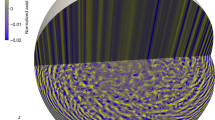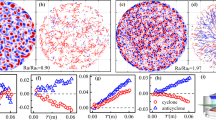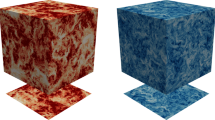Abstract
Turbulent rotating convection controls many observed features of stars and planets, such as magnetic fields, atmospheric jets and emitted heat flux patterns1,2,3,4,5,6. It has long been argued that the influence of rotation on turbulent convection dynamics is governed by the ratio of the relevant global-scale forces: the Coriolis force and the buoyancy force7,8,9,10,11,12. Here, however, we present results from laboratory and numerical experiments which exhibit transitions between rotationally dominated and non-rotating behaviour that are not determined by this global force balance. Instead, the transition is controlled by the relative thicknesses of the thermal (non-rotating) and Ekman (rotating) boundary layers. We formulate a predictive description of the transition between the two regimes on the basis of the competition between these two boundary layers. This transition scaling theory unifies the disparate results of an extensive array of previous experiments8,9,10,11,12,13,14,15, and is broadly applicable to natural convection systems.
This is a preview of subscription content, access via your institution
Access options
Subscribe to this journal
Receive 51 print issues and online access
$199.00 per year
only $3.90 per issue
Buy this article
- Purchase on Springer Link
- Instant access to full article PDF
Prices may be subject to local taxes which are calculated during checkout




Similar content being viewed by others
References
Spiegel, E. A. Convection in stars. Annu. Rev. Astron. Astrophys. 9, 323–353 (1971)
Ingersoll, A. P. & Porco, C. C. Solar heating and internal heat flow on Jupiter. Icarus 35, 27–43 (1978)
Hathaway, D. H. A convective model for turbulent mixing in rotating convection zones. Astrophys. J. 276, 316–324 (1984)
Busse, F. H. Convective flows in rapidly rotating sphere and their dynamo action. Phys. Fluids 14, 1301–1314 (2002)
Heimpel, M., Aurnou, J. & Wicht, J. Simulation of equatorial and high-latitude jets on Jupiter in a deep convection model. Nature 438, 193–196 (2005)
Aurnou, J., Heimpel, M., Allen, L., King, E. & Wicht, J. Convective heat transfer and the pattern of thermal emission on the gas giants. Geophys. J. Int. 173, 793–801 (2008)
Gilman, P. A. Nonlinear dynamics of Boussinesq convection in a deep rotating spherical shell. Geophys. Astrophys. Fluid Dyn. 8, 93–135 (1977)
Julien, K., Legg, S., McWilliams, J. & Werne, J. Hard turbulence in rotating Rayleigh-Bénard convection. Phys. Rev. E 53, 5557–5560 (1996)
Julien, K., Legg, S., McWilliams, J. & Werne, J. Rapidly rotating turbulent Rayleigh-Bénard convection. J. Fluid Mech. 322, 243–273 (1996)
Liu, Y. & Ecke, R. E. Heat transport in turbulent Rayleigh-Bénard convection: effects of rotation and Prandtl number. Phys. Rev. Lett. 79, 2257–2260 (1997)
Aurnou, J. M., Heimpel, M. & Wicht, J. The effects of vigorous mixing in a convective model of zonal flow on the ice giants. Icarus 190, 110–126 (2007)
Aurnou, J. M. Planetary core dynamics and convective heat transfer scaling. Geophys. Astrophys. Fluid Dyn. 101, 327–345 (2007)
Christensen, U. R. Zonal flow driven by strongly supercritical convection in rotating spherical shells. J. Fluid Mech. 470, 115–133 (2002)
Christensen, U. R. & Aubert, J. Scaling properties of convection-driven dynamos in rotating spherical shells and application to planetary magnetic fields. Geophys. J. Int. 166, 97–114 (2006)
Rossby, H. T. A study of Bénard convection with and without rotation. J. Fluid Mech. 36, 309–335 (1969)
Olson, P. L. & Christensen, U. R. Dipole moment scaling for convection-driven planetary dynamos. Earth Planet. Sci. Lett. 250, 561–571 (2006)
Takeshita, T., Segawa, T., Glazier, J. A. & Sano, M. Thermal turbulence in mercury. Phys. Rev. Lett. 76, 1465–1468 (1996)
Glazier, J. A., Segawa, T., Naert, A. & Sano, M. Evidence against ultrahard thermal turbulence at very high Rayleigh numbers. Nature 398, 307–310 (1999)
Greenspan, H. P. The Theory of Rotating Fluids (Cambridge Univ. Press, 1968)
Hignett, P., Ibbetson, A. & Killworth, P. D. On thermal rotating convection driven by non-uniform heating from below. J. Fluid Mech. 109, 161–187 (1981)
Boubnov, B. M. & Golitsyn, G. S. Temperature and velocity field regimes of convective motions in a rotating plane fluid layer. J. Fluid Mech. 219, 215–239 (1990)
Read, P. L. Transition to geostrophic turbulence in the laboratory, and as a paradigm in atmospheres and oceans. Surv. Geophys. 22, 265–317 (2001)
Tilgner, A. High-Rayleigh-number convection in spherical shells. Phys. Rev. E 53, 4847–4851 (1996)
Verzicco, R. & Camussi, R. Prandtl number effects in convective turbulence. J. Fluid Mech. 383, 55–73 (1999)
Schmalzl, J., Breuer, M. & Hansen, U. The influence of the Prandtl number on the style of vigorous thermal convection. Geophys. Astrophys. Fluid Dyn. 96, 381–403 (2002)
Chandrasekhar, S. The instability of a layer of fluid heated below and subject to Coriolis forces. Proc. R. Soc. Lond. A 217, 306–327 (1953)
Belmonte, A., Tilgner, A. & Libchaber, A. Temperature and velocity boundary layers in turbulent convection. Phys. Rev. E 50, 269–279 (1994)
Nimmo, F., Price, G. D., Brodholt, J. & Gubbins, D. The influence of potassium on core and geodynamo evolution. Geophys. J. Int. 156, 363–376 (2004)
Kutzner, C. & Christensen, U. R. From stable dipolar towards reversing numerical dynamos. Phys. Earth Planet. Inter. 131, 29–45 (2002)
Kunnen, R. P. J., Clercx, H. J. H. & Geurts, B. J. Heat flux intensification by vortical flow localization in rotating convection. Phys. Rev. E 74, 056306 (2006)
Acknowledgements
Salary support for E.M.K., J.N. and J.M.A. was provided by the US National Science Foundation Earth Sciences Division Geophysics Program and the NASA Planetary Atmospheres Program. Support for S.S. and U.H. was provided by the German Research Foundation and for S.S. by the NASA Solar and Heliospheric Physics Program. Support for laboratory experiment fabrication was provided by the US National Science Foundation Instrumentation & Facilities Program. Computational resources were provided by the John von Neumann-Institut für Computing. E.M.K., J.N. and J.M.A. would like to thank J. Frydman, J. Neal, A. Yaghmaei and R. M. Aurnou for engineering support in experimental development. E.M.K. and J.M.A. would like to thank H. T. Rossby for making his thesis data available to them, J. McWilliams for discussion and S. R. Dickman for introducing them to geophysics.
Author information
Authors and Affiliations
Corresponding author
Supplementary information
Supplementary Information
This file contains Supplementary Methods, Supplementary Discussions, Supplementary Figures 1-4 with Legends and Supplementary References (PDF 656 kb)
Rights and permissions
About this article
Cite this article
King, E., Stellmach, S., Noir, J. et al. Boundary layer control of rotating convection systems. Nature 457, 301–304 (2009). https://doi.org/10.1038/nature07647
Received:
Accepted:
Issue Date:
DOI: https://doi.org/10.1038/nature07647
This article is cited by
-
Sustaining Earth’s magnetic dynamo
Nature Reviews Earth & Environment (2022)
-
Inverse centrifugal effect induced by collective motion of vortices in rotating thermal convection
Nature Communications (2021)
-
Turbulent superstructures in Rayleigh-Bénard convection
Nature Communications (2018)
-
A rotating annulus driven by localized convective forcing: a new atmosphere-like experiment
Experiments in Fluids (2017)
-
Dynamo Scaling Laws and Applications to the Planets
Space Science Reviews (2010)
Comments
By submitting a comment you agree to abide by our Terms and Community Guidelines. If you find something abusive or that does not comply with our terms or guidelines please flag it as inappropriate.



